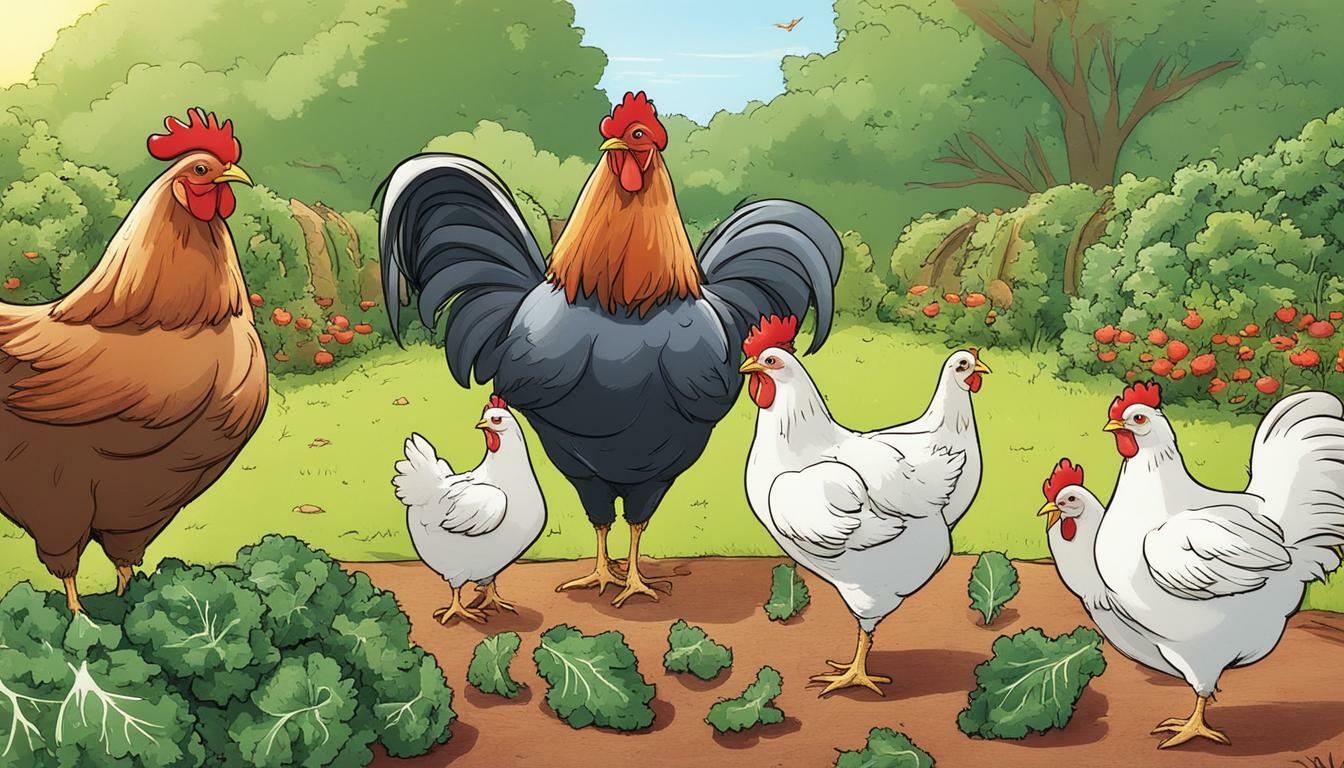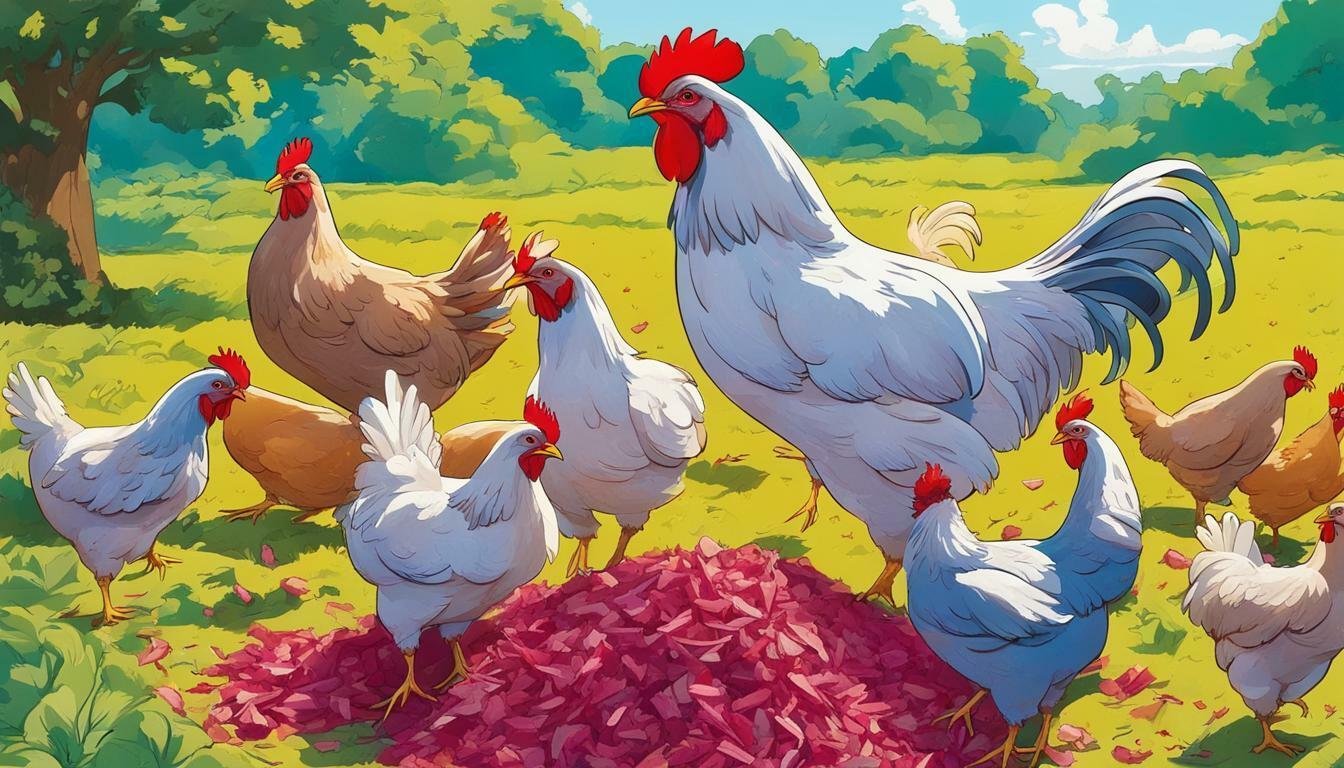Can Chickens Eat Kale? Benefits And Tips for Feeding

Table of content:
- Is Kale Good for Chickens?
- What Greens Can Chickens Eat?
- Are Kale Leaves Safe for Chickens?
- Can I Feed My Chickens Kale Everyday?
- How Much Kale Can I Feed My Chickens?
- What Are the Benefits of Feeding Chickens Kale?
- Is Raw or Cooked Kale Better for Chickens?
- Does Kale Upset Chicken’s Stomach?
- When Can I Start Feeding Kale to Baby Chicks?
- Final Thoughts
Kale has become an increasingly popular leafy green for us humans to eat in recent years, recognized for its stellar nutritional profile. This has left many chicken owners wondering if kale would also make a good addition to their flock’s diet.
Is Kale Good for Chickens?
Kale contains vitamins A, C, and K, antioxidants, beta-carotene, calcium, potassium, thiamine, riboflavin, and iron. This makes it quite nutritious for chickens. Kale provides many key vitamins and minerals that are great for your chickens’ overall health.
Some key benefits of feeding chickens kale include:
- Protein – Kale contains over 4 grams of protein per cup, providing an excellent protein source. Protein is essential for growth and egg production.
- Calcium – Calcium is necessary for strong eggshells. Kale contains over 100 mg of calcium per cup.
- Antioxidants – Kale is high in antioxidants like lutein and beta-carotene. These support eye and skin health.
- Iron – Iron carries oxygen throughout the body and helps prevent anemia. Kale provides almost 2 mg of iron per cup.
- Vitamins A, C, K – These vitamins support immune function and overall wellbeing.
So kale can certainly be a nutritious addition to your flock’s diet. It provides vital nutrients that support their health and productivity.
What Greens Can Chickens Eat?
Chickens can eat a wide variety of leafy greens as part of a balanced diet. Some other greens you can offer your flock include:
- Spinach – High in niacin, zinc, protein, vitamins A, C, E and K. Feed in moderation due to oxalates.
- Lettuce – Romaine, red leaf, and green leaf lettuce provide nutrition without causing diarrhea.
- Swiss Chard – Loaded with vitamins A, C, E, K, and minerals. Can feed leaves and stems.
- Cabbage – Excellent source of vitamins C and K. Can be fed raw or cooked.
- Sprouts – Chickens love sprouted grains and seeds like wheatgrass, alfalfa, radish, broccoli, etc.
- Celery – Provides calcium, phosphorus, vitamins A and C. Chop stalks into small pieces.
- Endive – Nutritious and easy for chickens to digest. High in vitamin K.
- Fruit – Small amounts of banana, berries, melon, apple, tomato, etc. Offer as occasional treats.
This variety gives your hens balanced nutrition and keeps their diet interesting! Feed a mixture of greens daily.
Are Kale Leaves Safe for Chickens?
Kale leaves are completely safe and non-toxic for chickens to consume. Both curly kale and dinosaur kale contain nutrients that are beneficial for chickens. You do not need to worry about kale poisoning poultry or causing any harm.
Kale does contain oxalates, which can potentially bind to calcium and cause nutritional deficiencies in excess amounts. However, feeding kale in moderation along with a balanced diet is not an issue.
Some tips for feeding kale safely:
- Chop or shred into bite-sized pieces for easier eating.
- Feed just a handful per chicken per day with their regular feed.
- Mix with other greens and treats. Variety is key!
- Introduce slowly if new to their diet.
As long as you follow these tips, your flock can enjoy kale as an occasional part of their diet without risk. It provides healthy nutrients chickens can benefit from.
Can I Feed My Chickens Kale Everyday?
It’s fine to feed your chickens small amounts of kale regularly or even daily. But kale should not be the only green you feed them. Variety is important to prevent boredom and provide a mix of nutrients.
Ideally, you should rotate 3-5 different greens throughout the week. For example, you might offer:
- Kale 2-3 times per week
- Spinach 1-2 times per week
- lettuce 2 times per week
- Swiss chard 1-2 times per week
- Celery leaves 1-2 times per week
Feed just one or two handfuls of kale per chicken per day, along with their regular feed and treats.
You can also mix it up by offering a “salad bar” of mixed greens and let your hens selectively choose what they want to eat. This provides stimulation and encourages their natural foraging behavior.
The key is providing a diverse diet, not just exclusively kale everyday. But offering some kale several times a week can certainly be part of a balanced diet.
How Much Kale Can I Feed My Chickens?
When feeding your backyard flock kale, moderation is key. Chickens should not get more than 1-2 handfuls of kale leaves per chicken per day. A handful is around 1/2 cup of chopped kale.
You don’t want kale to make up more than 10% of their overall daily diet. The majority of their diet should still be their complete feed and grit.
Overfeeding kale could lead to an upset digestive system, diarrhea, or nutritional deficiencies over time if they fill up on greens instead of eating their layer feed.
Try to offer kale in portions alongside their regular food ration. Their main diet should still consist of:
- Complete poultry feed
- Calcium/grit supplement
- Fresh clean water
Watch to see if your chickens are gobbling up all the kale right away. If they seem disinterested after eating some, they have likely had enough for the day.
Stick to no more than 1-2 handfuls of kale per chicken daily as part of a varied fresh foods diet, and they’ll benefit from the healthy nutrients kale provides!
What Are the Benefits of Feeding Chickens Kale?
Adding some kale to your chickens’ diet provides them with a boost of valuable nutrients that offer several key health benefits:
- Protein – Kale contains over 4g of protein per cup, supporting growth and egg production.
- Calcium – Kale provides abundant calcium for proper bone development and strong eggshells.
- Antioxidants – Powerful antioxidants like lutein and beta-carotene promote eye and skin health.
- Vitamin C – This bolsters immune function and helps bodies absorb iron. Kale has over 80 mg vitamin C per cup.
- Vitamin K – Supports blood clotting. Kale exceeds the daily vitamin K requirement.
- Thiamine – Helps convert carbs into energy. Kale provides over 10% of the daily need per cup.
- Iron – Carries oxygen through the bloodstream. Kale has almost 2 mg iron per cup.
By incorporating some kale into your chickens’ diet, you’ll provide them with more nutrients that support their health, production, growth and happiness!
Is Raw or Cooked Kale Better for Chickens?
Chickens can eat kale raw or cooked. Both forms provide excellent nutrition.
Raw kale retains more vitamins like C, B6, and K. Lightly cooking kale can make it easier to digest while still preserving nutrients.
Quick steaming, blanching or sauteing kale softens the leaves so your chickens can eat it more easily. Try chopping kale into bite-sized pieces first.
With raw kale, be sure to chop it finely and mix with their feed so they don’t ignore tiny raw pieces.
You can alternate between raw and lightly cooked kale for more variety. Just don’t boil kale to mush, as overcooking destroys nutrients.
Offer kale in its fresh raw form or lightly wilted, and your chickens will reap all the great benefits kale has to offer!
Does Kale Upset Chicken’s Stomach?
Eating too much raw kale on occasion may cause mild digestive upset in some sensitive chickens. You might notice:
- Loose droppings
- Abnormal poop
- Lack of appetite
- Listlessness
This is not extremely common, but possible. It does not mean kale is toxic, just fed in excess.
To avoid stomach issues, introduce kale slowly and feed conservatively as part of a varied diet. Chop kale into small, bite-sized pieces so it is easier to digest.
Make sure your chickens always have their complete feed available as their dietary foundation. Monitor portions if feeding kale daily.
Usually minor diarrhea from greens will resolve on its own. Remove kale for a few days if birds seem unwell. Call a vet for prolonged issues.
With proper portion control and diet, kale can be fed safely. But as with any treat, listen to your chicken’s health signals.
When Can I Start Feeding Kale to Baby Chicks?
You should wait until baby chicks are fully feathered and around 4-6 weeks old before offering greens like kale. Their digestive systems take time to mature.
Until then, chicks under 4 weeks old should eat only starter feed formulated specifically for their nutritional needs. Starter feed provides:
- 20-24% protein
- 2.5-3.5% calcium
- Key vitamins/minerals
- Medication for immunity
Do not give chicks adult layer feed, treats, or greens until they are 4-6 weeks old. Their digestive tracts cannot yet handle it.
Once feathered, you can slowly introduce greens by finely chopping a few tiny pieces into their feed. Limit portions, watch for issues, and withdraw if any problems.
By 10-12 weeks old, chicks can eat normal portions of greens like kale alongside their grower feed. Mix with crumbles and limit free feeding to prevent overconsumption.
With patience and proper diet in early stages, kale can supplement nutrition down the line once chick’s bodies adjust around 4-6 weeks old.
Final Thoughts
In conclusion, most backyard chickens can benefit from eating some kale as part of their regular diet. The nutrients and minerals kale provides support chicken health and egg production. Introduce greens like kale slowly, feed in moderation 1-2 times per day, and mix with their complete feed for balanced nutrition. Monitor your flock while making any dietary changes and adjust as needed. With these best practices, kale and other leafy greens make an excellent supplemental addition to your chickens’ menu!
Welcome. I’m Adreena Shanum, the proud owner of this website, and I am incredibly passionate about animals, especially poultry. I founded adreenapets.com as a labor of love, stemming from my desire to share my knowledge and experiences with poultry enthusiasts worldwide.




